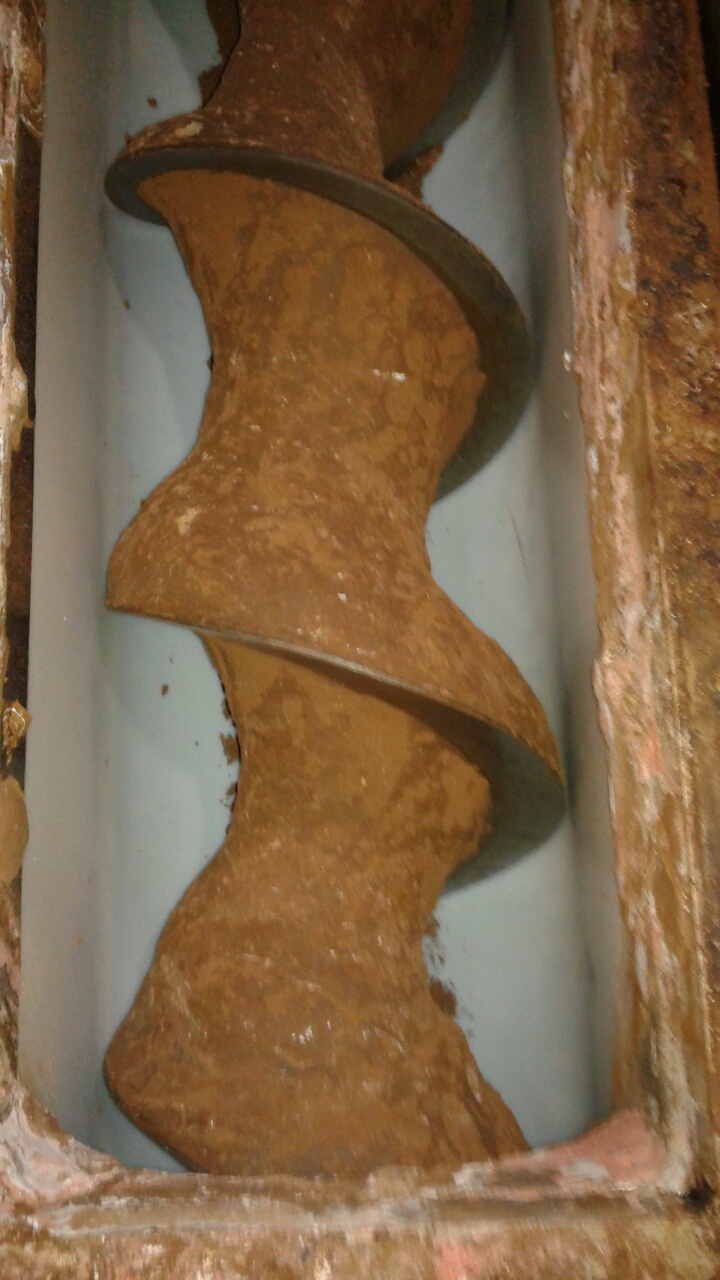
Clogging Of Screw
Please confirm that there is no hanger bearing in this length, the conveyor is horizontal and the feed is steady and within the screws capacity. What is the nature of the clogging? - sticking to fill the volume of the screw, binding on the residue in the casing or blocked outlet?
can you past a photo of the problem? ■
Re: Ferlilizer Industry
can you past a photo of the problem?
Dear Mr. Bates,
thanks for the reply , I think nature of clogging is , sticking to fill of the volume of screw , any way I will send photos ?
can I have yours email, then I can send copy for your mail
regards
uditha ■
Re: Ferlilizer Industry
dear Mr. Lyn,
nature of cloging is "sticking to fill the volume of the screw"
please refer attached

photos
regards
uditha ■
Re: Ferlilizer Industry
I have examined your photographs and see that material has built up to leave only a small, curved space between the flights that will exert a strong compacting force on the limited amount of material that it can move.
The reason that the screw is clogging is that it has the wrong form of flight construction for the nature of the material being handled. The helix angle of the working face of screw flight face varies considerably from the tip to the point of attachment to the shaft because the central region has to attain the same pitch as the outside on a much smaller circumference around the shaft. Allied to this, the ‘corner effect’ of the flight to the shaft offers a large surface area to stick to in a region furthest from the boundary where the material is resisted from rotation. Gravity also has a lower effect in the centre than the outer regions, as the material has only a short distance to be lifted to carry it round with the shaft. A final point is that the shaft surface has no axial transfer effect and anything that sticks on this large area will rotate with the shaft and then give a rough surface on which further material can build up, compared with the smoother surface of the original metal. i.e. one the material starts building up it is more likely to continue.
As to what can be done, by far the best solution is to fit a now screw that has a more suitable construction to resist clogging. More of this later. In the short and cheap term, speeding up the screw considerably to lower the cross sectional loading and ensuring that the in-feed does not touch the centre shaft MAY allow a clean screw to remain clean, or at least run for a longer period before it has to be cleaned again. I must say that this is an expedient approach without any guarantee of long term reliability. If the location is relatively inaccessible and cheap, skilled labour is available, the current screw COULD be modified, by plasma cutting multiple regions out of the central regions of the flights and dressing the remainder In practice, this demands expert advice on requirements and, in the developed world, would be more expensive than a new screw because considerable hand work would be necessary to secure the best shape and finish and straightening of the screw.
A screw form is made by Ajax that is constructed to a registered ‘Lynfow’ design to specifically resist clogging. The flights are laser cut with a special profile of tangential ribs and optimum proportioned ribbon flights. To make such a new screw we would require either certified dimensions of the existing screw or the existing screw to be sent to our works. A quotation for such a screw in mild steel construction will be sent for your consideration. ■
Solution
Hello, please send us the sketch of the facility for us to try to solve your problem: gcarmi@flow-industries.com
we are facing fallowing problem , we have 300mm u trough screw conveyor for transport urea / Phosphate to elevator
Total length is 20 ft , before loading screw conveyor there is fixed mesh and shedder.
issue is after few days , screw conveyor is not working properly ,it is cloging
any expert can give a advise
we are planning to fixed high speed air nozzles , along with screw housing ?
Providing induction heating for conveyor outer ? reduce RH for reduce hygroscopic nature ?
hope to good advise
regards
uditha
■





Ferlilizer Industry
Hi
we are facing fallowing problem , we have 300mm u trough screw conveyor for transport urea / Phosphate to elevator
Total length is 20 ft , before loading screw conveyor there is fixed mesh and shedder.
issue is after few days , screw conveyor is not working properly ,it is cloging
any expert can give a advise
we are planning to fixed high speed air nozzles , along with screw housing ?
Providing induction heating for conveyor outer ? reduce RH for reduce hygroscopic nature ?
hope to good advise
regards
uditha ■